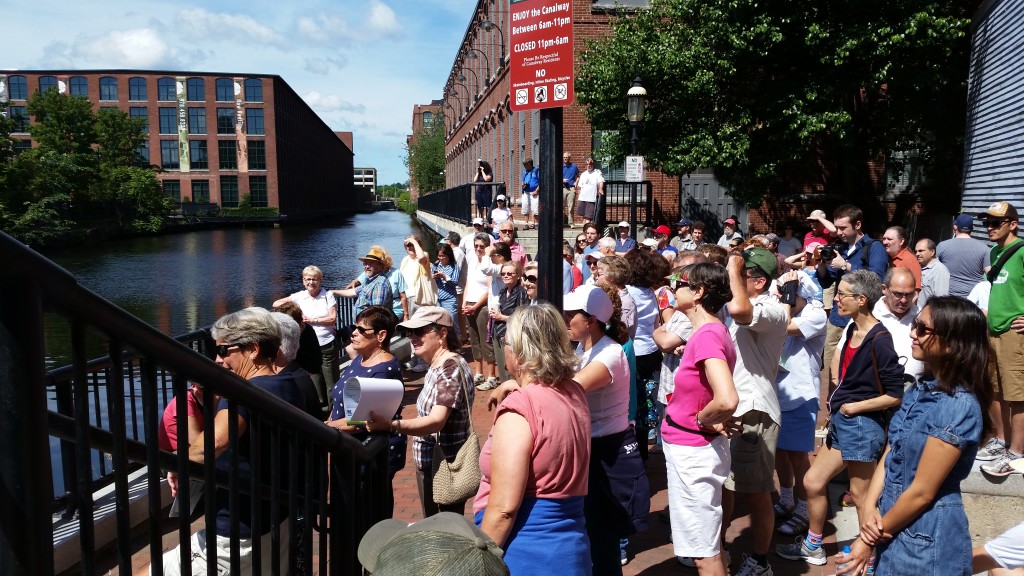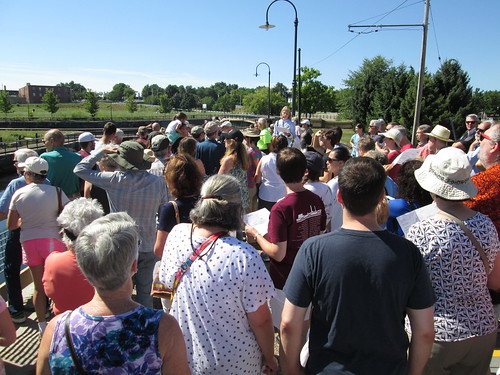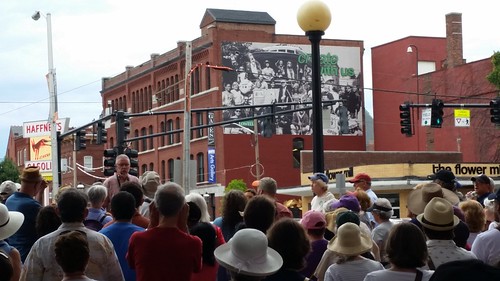What next for Lowell Walks?


Allison Lamey leading 129 people on tour of Hamilton Canal District
I spent this past week in Washington helping my son Andrew move into the apartment he’ll live in while attending graduate school so I missed much of what went on in Lowell since last Sunday. I did return in time for yesterday’s Lowell Walks tour on the Hamilton Canal District. Allison Lamey, the city’s Economic Development Director, did a fantastic job leading the tour which was attended by 129 people.
With eight of fifteen tours completed, Lowell Walks has averaged 96 participants per tour. (Tours continue each Saturday until September 12, 2015). Because these Saturday walks have tapped into a large vein of interest among Lowell residents (who make up most of the attendees), I decided to use today’s post to review how Lowell Walks came about and where it might be headed in the future.
Five or six years ago the late Catherine Goodwin, then in her 80s, solicited a volunteer to take over the Lowell Cemetery tours that she had originated nearly 30 years earlier. I offered my services and Catherine shared with me her notes and advice. Since then, I’ve given perhaps 60 tours of the cemetery for groups ranging from 10 to 120 (here is the Fall 2015 tour schedule).
From this experience I learned a couple of things. People love good stories. It almost doesn’t matter the topic; if you can be engaging and deliver some interesting, thought-provoking information, it taps into something in the core of every human being. Also, nothing can replace being on the ground, standing shoulder-to-shoulder with others, when you hear such a story. I’m a huge proponent of social media, video, and the internet but there is no substitute for seeing, hearing, smelling and feeling a place.
While the Lowell Cemetery tours informed this observation, other events sent a similar message. Every March during Irish Cultural Week, Dave McKean would draw a big crowd for his Irish in the Acre tour. The same thing happened with Lowell Celebrates Kerouac and their occasional tours of Kerouac’s Lowell.

Dave McKean’s Irish in the Acre tour at Ladd & Whitney monument
Public Matters, the leadership training program co-sponsored by the Lowell Plan and Lowell National Historic Park, always devotes a Saturday morning to neighborhood tours led by volunteer guides from each corner of the city. I often am the guide for the Highlands and the experience of introducing people new to the city or to that section of the city to the Highlands proved to me that there is something of interest to be found in every corner of Lowell.
The greatest concentration of interesting places is by far downtown Lowell. While the National Park is “in” downtown and the tours conducted by its personnel are outstanding, those tours are also somewhat repetitive which is completely understandable. Whether it’s Lowell or Gettysburg, the target audience is the one-time visitor, so the stories to be shared should be standardized and should use the local as a way of connecting to broader national themes.
Lowell residents are certainly welcome on the NPS tours and should participate in them. I did that last summer with the canal boat tours. Three times. Each time an out-of-town relative or friend would visit, I would insist on taking the canal boat tour because it is incredible. But truth be told, by the third tour, I felt I could give it because the story was the same each time. That’s not a criticism because the target audience is the one-time visitor. But once someone from Lowell has taken the NPS tour, there was not much to bring him or her back to Lowell National Park.
That got me thinking: What if downtown tours had different topics that changed from week to week? Would Lowell people participate in them? I decided to find out by organizing a series of walking tours of downtown Lowell. I called it Lowell Walks.
Following the “keep it simple” principle of management, I wanted each of the tours to start at the same time and place so there was predictability for potential attendees. The National Park Visitor Center on Market Streets seemed like a perfect starting point. It’s centrally located, there is plenty of parking nearby, there are interesting exhibits and artifacts on display, there is a bathroom for those who need it, and the tour attendees could legitimately be counted as visitors to the park.
Next, I reached out to acquaintances in Lowell who I knew had expertise in particular areas. Almost everyone I asked immediately agreed to participate. The toughest thing was scheduling the fifteen tour guides into the fifteen Saturdays but everyone was flexible and it worked out fine. From there, it was completely decentralized. Each tour guide was responsible for the content, the route and for recruiting participants. While there was no budget, we did receive in-kind contributions from the National Park (use of visitor center space), University of Massachusetts Lowell (posters and brochures), the Lowell Historic Board (“Lowell Walks” stickers) and the Lowell Heritage Partnership (voice amplifiers).
The result? Our first eight tours have brought 766 people into downtown Lowell. Some are repeat visitors but most are new to the tours. The variety of attendees is brought home to me every Saturday night when I upload the photos I took earlier in the day to Facebook and start “tagging” the faces I recognize. There aren’t many amongst the big crowd. I am delightedly left asking, “Who are all of these people?”
Mostly they are residents of the city who are interested in the story of their city. They seek authenticity and context. Their mere presence enhances the collective sense that this place and its stories are important, are worth being heard and repeated.
So what happens next? Certainly Lowell Walks will return next summer with its schedule and topics to be determined over the winter. But there’s much more that can be done. Every neighborhood in the city has fantastic places and fantastic stories. If you grew up in the neighborhood, you may be familiar with them but if you’re from another section of the city or a newcomer altogether, you would probably welcome the chance to learn more. Other possibilities are specialized tours of restaurants, churches, parks, even a ghost tour. The possibilities are endless. Suggestions are welcome. Please make them.
But this just isn’t about creating new tours. Every day, throughout the city there are talented, energetic people doing interesting things they willingly share with others. Perhaps the challenge is not finding things to do in Lowell. The real challenge is to find people to do those things. It’s sort of like that Walt Whitman quote: “To have great poets, there must be great audiences.” Maybe the key is to focus on the audience and not on the event.

Bob Forrant’s Abolitionists in Lowell tour
Reinforcements will arrive in three weeks when thousands of students and staff from UMass Lowell, Middlesex Community College, and Lowell High School return to downtown on a daily basis. That should come as a surprise to no one and anyone who claims to be interested in promoting both downtown and Lowell in its entirety should be working overtime between now and Labor Day to find ways to share the enthusiasm the Lowell Walks participants have shown for the city and its people with the newly arriving students. Conversely, the resumption of the academic calendar will yield countless events and opportunities for Lowell residents to participate in college activities.
It’s not a coincidence that Broadway (the performance venue in New York City; not the street in Lowell) is undergoing a once-in-a-generation transformation with the arrival of Hamilton, a musical that uses rap, hip-hop, and R&B to tell the story of the founding of the American nation (see recent NY Times review). In our turbulent political age with its 24-hour news cycle in which facts matter only so far as they can be used to spin a political agenda, history provides some permanence, some stability and, most importantly, some context in which to better assess contemporary events. It’s no coincidence that the Hamilton Canal District we toured yesterday is named for the same Alexander Hamilton who is the inspiration for the transformative Broadway musical.
Lowell is rich in history. It is rich in the fascinating stories that are history. Lowell Walks has demonstrated that Lowell residents will come together in large groups to hear those stories. We should provide more opportunities for them to do so.
I appreciate the new opportunities through Lowell Walks. I understand that you want to promote your activity but the NPS has done a great deal for Lowell so don’t put them down. It’s not a competition.
I used the words “incredible” and “outstanding” to describe the National Park tours so it wasn’t my purpose to put down Lowell National Park. However, I was pointing out the limitations facing the National Park due to its statutory mission and limited budget. The park is here to use Lowell to tell the bigger story of immigration and the Industrial revolution to visitors from across the country and the world. If you live here and have been on the tours, there is not much incentive to go back again and again. A “local history gap” results. Too often, those who should help fill that gap have abdicated their responsibility by seeing the Park as a cash cow that can handle the history stuff by itself. But the Park by itself can only do so much.
Much of Lowell’s success over the past 40 years was driven by private-public partnerships. That’s a model that should be embraced when it comes to sharing the great history of Lowell with its residents and frequent visitors. Lowell Walks shouldn’t be viewed in isolation but as part of a bigger Lowell history ecosystem that supplements, supports and extends the National Park beyond what it can do by itself.
Dick, I know we didn’t get very far in our planning since most fire stations are too spread out for a walking tour, but a fire tour of historic locations downtown would work. There were many major building fires downtown over the years. A theme like saving downtown would work. Boston has a similar “fire trail” concept.
Definitely agree with Richard here. I certainly did not take it as a put-down, rather an observation that the NPS cater their tours to non-residents. The walking tours that have been held this summer are more ‘peel back the onion’ tours to provide deeper info and color.
I live here, have been on several NPS tours, my family and I had a another great trip in July. “Not much incentive to go back again and again”? I disagree and greatly appreciate what the NPS does for Lowell.
Tuesday we. took a canal boat/trolley tour mainly to go through the locks with a 7 and 4 year old. I’ve done the LNP tour numerous times (did one last year) and we were very focused on watching the kids so they’d have a good time. Our ranger was okay, but the talk was definitely aimed at the one time visitor not us. If you live in Lowell or have done the tour with out of town visitors, you can probably give the tour yourself after listening to the same range speil. Which is okay. When I visit a new city that’s what I want on a tour. When you live in a place, you want more history and insight into your “place” and that is what these walks are doing.
Jason, great idea. I’ll put the downtown fires topic on the 2016 list. And let’s not give up on the fire station tour. It will take some work, but I definitely see us going mobile in the not too distant future.
Big thumbs up for Lowell Walks! It’s been great to see the turn-out each week, drawn to interesting subject matter and speakers, reinforcing that there is a high level of interest in Lowell history and support for programs like this. We see this at Doors Open Lowell each May during Preservation Month as many come out to explore historic buildings and how they’ve been restored and reused.
In the past, prior to Doors Open, the Historic Board would present several Preservation Week/Month events including walking tours of neighborhood historic districts listed on the National Register of Historic Places such as Washington Square (Kittredge Park), Belvidere Hill, and Tyler Park. We routinely would get 60-70 people on these walks and people enjoyed learning about the various architectural styles and historic figures associated with the homes. One year some enterprising children on Mansur Street even set up a lemonade stand to take advantage of our tour group and did quite well! There is definitely an appetite out there for public history programming like this, Doors Open Lowell, Lowell Walks, etc.
When I was at the National Park in the mid-1980s through the early 1990s, during the summer I would coordinate a program known as Tour du Jour which was a 6-8 week long program of daily special interest tours. These tours would dive into subject matter that was more specialized, touching on a variety of topics including architectural history, renovation/revitalization, immigration, churches, environmental/natural history, public art, among others. Very popular and they nicely supplemented other Park programming.
One very popular tour we would offer was related to Lowell’s patent medicine industry as there are several sites associated with it in downtown. Old City Hall (where Father John’s Medicine was originally concocted), Ayer’s on Middle/Market, Father John’s on Market, and Hoyts German Cologne on Middlesex Street were all stops and people enjoyed learning about this major industry in the shadow of the textile mills, their pioneering efforts at mass-marketing, and the questionable therapeutic value of many of the products. I would suggest adding a patent medicine tour to the roster of Lowell Walks in 2016.
The NPS tours give a broad overview of the city and its history. Lowell Walks explores the little niches: the Appomattox mural at the Pollard, the second floor of the Palmer Street fire station, the “flying lobsters” and the unlikely Tsongas-Tully alliance for public art. Didn’t Thoreau say “I have traveled a good deal in Concord”? LW allows us to travel a good deal in Lowell.
Glad to hear you are hoping to go mobile, Dick! In that vein, I would love to see a tour of Cambodiatown.
LizS, We’re already working on a Cambodiatown/Lower Highlands tour that would combine the neighborhood’s 19th century history (home to a professional baseball team and park, for instance) with an detailed explanation of its current incarnation as home to many of the city’s Cambodian residents. The tour would probably begin at Clemente Field and end across the street at Pailin Plaza.
Hi, a few suggestions for walks:
1) Waterways tour
2) Food history tour – may include visits to restaurants, but maybe not the focus
3) Pub crawl – not to drink, but to learn about watering holes past and present
4) Major crimes of Lowell tour
5) Contemporary history of art as an industry in Lowell – Revolving Museum, etc. etc.
My wife and I are newcomers to Lowell and have dedicated to learning as much about our new city as possible. Some of this learning has been required, as we attempt to traverse the city, dealing with traffic knots that occur as schools, commuters, tourists and businesses add interesting variations to the problem of commuting by car in Lowell.
Fortunately, Lowell is a walkable city, by some estimates ranking in the high 90th percentage of walkability nationwide. The high preponderance of locals, who delight in talking about their city, makes every walk an education. Whether Richard’s Lowell Walks, or the NPS guided tours, or the artists in the Whistler Gallery/Artist’s Lofts, or the people next to us at the street corner, it is obvious that locals take great pride in relating their unique ties to Lowell.
It did not take long to fall in love with Lowell, and after that to dedicate to our new adopted city by purchasing a property.
With our investment, we now would like to see tours added to help us know and become more involved in the future and planned development of Lowell. We would like, for instance, to see a tour conducted at the site of the new Hamilton Canal District Project. The internet is rich with descriptions of meetings from the 2008 timeframe that informed the public of the Master Plan, and the selection of the prime developer. Everything that I could find online stated that there was some variability allowed by the plan to allow developers’ enhancements. Recent stories announced the excitement as the prime developer withdrew from the project. Selection of a new prime will invariably involve some adjustment to the Master Plan.
I think that locals would be very interested in forum (tours?) at the sites of planned or proposed development, e.g. HCDP, to bring us up to date with ongoing discussions affecting our city.